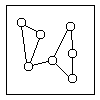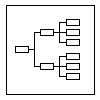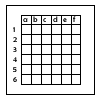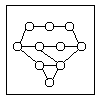
Seven Management and Planning Tools
Encyclopedia
The Seven new Management and Planning Tools have their roots in Operations Research
work done after World War II
and the Japan
ese Total Quality Control (TQC) research. In 1979 the book Seven New Quality Tools for Managers and Staff was published and in 1983 was translated into English.
Affinity Diagram
 This tool takes large amounts of disorganized data and information and enables one to organize it into groupings based on natural relationships. It was created in the 1960s by Japanese anthropologist Jiro Kawakita. Its also known as KJ diagram,after Jiro Kawakita. Affinity diagram is a special kind of brainstorming tool.
This tool takes large amounts of disorganized data and information and enables one to organize it into groupings based on natural relationships. It was created in the 1960s by Japanese anthropologist Jiro Kawakita. Its also known as KJ diagram,after Jiro Kawakita. Affinity diagram is a special kind of brainstorming tool.
Interrelationship Digraph
 This tool displays all the interrelated cause-and-effect relationships and factors involved in a complex problem and describes desired outcomes. The process of creating an interrelationship digraph helps a group analyze the natural links between different aspects of a complex situation.
This tool displays all the interrelated cause-and-effect relationships and factors involved in a complex problem and describes desired outcomes. The process of creating an interrelationship digraph helps a group analyze the natural links between different aspects of a complex situation.
Tree Diagram
 This tool is used to break down broad categories into finer and finer levels of detail. It can map levels of details of tasks that are required to accomplish a goal or task. It can be used to break down broad general subjects into finer and finer levels of detail. Developing the tree diagram helps one move their thinking from generalities to specifics.
This tool is used to break down broad categories into finer and finer levels of detail. It can map levels of details of tasks that are required to accomplish a goal or task. It can be used to break down broad general subjects into finer and finer levels of detail. Developing the tree diagram helps one move their thinking from generalities to specifics.
 This tool is used to prioritize items and describe them in terms of weighted criteria. It uses a combination of tree and matrix diagramming techniques to do a pair-wise evaluation of items and to narrow down options to the most desired or most effective.
This tool is used to prioritize items and describe them in terms of weighted criteria. It uses a combination of tree and matrix diagramming techniques to do a pair-wise evaluation of items and to narrow down options to the most desired or most effective.
 This tool shows the relationship between items. At each intersection a relationship is either absent or present. It then gives information about the relationship, such as its strength, the roles played by various individuals or measurements. Six differently shaped matrices are possible: L, T, Y, X, C, R and roof-shaped, depending on how many groups must be compared.
This tool shows the relationship between items. At each intersection a relationship is either absent or present. It then gives information about the relationship, such as its strength, the roles played by various individuals or measurements. Six differently shaped matrices are possible: L, T, Y, X, C, R and roof-shaped, depending on how many groups must be compared.
Process Decision Program Chart
 A useful way of planning is to break down tasks into a hierarchy, using a Tree Diagram. The PDPC extends the tree diagram a couple of levels to identify risks and countermeasures for the bottom level tasks. Different shaped boxes are used to highlight risks and identify possible countermeasures (often shown as 'clouds' to indicate their uncertain nature). The PDPC is similar to the Failure Modes and Effects Analysis
A useful way of planning is to break down tasks into a hierarchy, using a Tree Diagram. The PDPC extends the tree diagram a couple of levels to identify risks and countermeasures for the bottom level tasks. Different shaped boxes are used to highlight risks and identify possible countermeasures (often shown as 'clouds' to indicate their uncertain nature). The PDPC is similar to the Failure Modes and Effects Analysis
(FMEA) in that both identify risks, consequences of failure, and contingency actions; the FMEA also rates relative risk levels for each potential failure point.
 This tool is used to plan the appropriate sequence or schedule for a set of tasks and related subtasks. It is used when subtasks must occur in parallel. The diagram enables one to determine the critical path
This tool is used to plan the appropriate sequence or schedule for a set of tasks and related subtasks. It is used when subtasks must occur in parallel. The diagram enables one to determine the critical path
(longest sequence of tasks). (See also PERT
diagram.)
Operations research
Operations research is an interdisciplinary mathematical science that focuses on the effective use of technology by organizations...
work done after World War II
World War II
World War II, or the Second World War , was a global conflict lasting from 1939 to 1945, involving most of the world's nations—including all of the great powers—eventually forming two opposing military alliances: the Allies and the Axis...
and the Japan
Japan
Japan is an island nation in East Asia. Located in the Pacific Ocean, it lies to the east of the Sea of Japan, China, North Korea, South Korea and Russia, stretching from the Sea of Okhotsk in the north to the East China Sea and Taiwan in the south...
ese Total Quality Control (TQC) research. In 1979 the book Seven New Quality Tools for Managers and Staff was published and in 1983 was translated into English.
Affinity DiagramAffinity diagramThe affinity diagram is a business tool used to organize ideas and data. It is one of the Seven Management and Planning Tools.The tool is commonly used within project management and allows large numbers of ideas stemming from brainstorming to be sorted into groups for review and analysis.The...
(KJ Method)

Interrelationship DigraphDigraphDigraph may refer to:* Digraph , a pair of characters used together to represent a single sound, such as "sh" in English* Typographical ligature, the joining of two letters as a single glyph, such as "æ"...
(ID)

Tree DiagramTree diagramThe term tree diagram refers to a specific type of diagram that has a unique network topology. It can be seen as a specific type of network diagram, which in turn can be seen as a special kind of cluster diagram.-Applications:...

Prioritization Matrix

Matrix Diagram

Process Decision Program ChartProcess decision program chartProcess Decision Program Chart is a technique designed to help prepare contingency plans. The emphasis of the PDPC is to identify the consequential impact of failure on activity plans, and create appropriate contingency plans to limit risks...
(PDPC)

Failure mode and effects analysis
A failure modes and effects analysis is a procedure in product development and operations management for analysis of potential failure modes within a system for classification by the severity and likelihood of the failures...
(FMEA) in that both identify risks, consequences of failure, and contingency actions; the FMEA also rates relative risk levels for each potential failure point.
Activity Network Diagram

Critical path method
The critical path method is an algorithm for scheduling a set of project activities. It is an important tool for effective project management.-History:...
(longest sequence of tasks). (See also PERT
Program Evaluation and Review Technique
The Program ' Evaluation and Review Technique, commonly abbreviated PERT, is a statistical tool, used in project management, that is designed to analyze and represent the tasks involved in completing a given project...
diagram.)
Further reading
- Brassard, M. (1996) The Memory Jogger Plus+. ISBN 1-879364-83-2.
- Seven New Management and Planning Tools
- Seven Basic Tools of Quality
External links
- American Society for Quality - official Web site
- The 'New' Tools from Vanderbilt UniversityVanderbilt UniversityVanderbilt University is a private research university located in Nashville, Tennessee, United States. Founded in 1873, the university is named for shipping and rail magnate "Commodore" Cornelius Vanderbilt, who provided Vanderbilt its initial $1 million endowment despite having never been to the...
- A Periodic Table of Visualization Methods for Management
- Visualization Methods Exploration

